|
MERRELL ATLAS FLEECE JACKET
TEST SERIES BY DAVID TAGNANI
LONG-TERM REPORT
April 22, 2009
CLICK HERE TO SKIP TO THE FIELD REPORT
CLICK HERE TO SKIP TO THE LONG-TERM REPORT
TESTER INFORMATION
|
NAME:
|
David Tagnani
|
|
EMAIL:
|
dtagnani@hotmail.com
|
|
AGE:
|
32
|
|
LOCATION:
|
Spokane, Washington
|
|
GENDER:
|
m
|
|
HEIGHT:
|
5' 10" (1.78 m)
|
|
WEIGHT:
|
160 lb (72.60 kg)
|
Backpacking Background: I have been camping and hiking for as long as I can remember, but I've really only been backpacking for a decade. I started off in the hills of northeastern and central Pennsylvania, have hiked trails from Maine to Georgia, and now I am exploring the incredible terrain of the inland northwest. I seldom do trips longer than three days, with most trips being overnighters. I do not own crampons, an ice axe, or a climbing harness, so if the route is technical enough to require them, you won't find me there. I simply like to walk in the woods.
INITIAL REPORT
PRODUCT INFORMATION & SPECIFICATIONS
 | | courtesy of Merrell.com |
Manufacturer: Merrell
Year of Manufacture: 2008
Manufacturer's Website: Merrell.com
MSRP: 149 US$
Measured Weight: 22.6 oz (641 g)
Size: M (S-XXL available)
Color: Dark Olive (Putty also available)
Features:
- Dual zip hand pockets
- Zip chest pocket
- Full-length zipper
- Drawcord hem
Materials:
- 100% Polyester
- Merrell's trademarked AeroBlock fabric
- Combination of orbital and jersey fabrics
Merrell's Atlas jacket is touted on their website as a lightweight, wind- and water-resistant jacket. Mainly, they seem to promote their AeroBlock fabric as "highly wind-resistant and breathable."
INITIAL IMPRESSIONS - Dec 08
I was expecting a somewhat burlier jacket; not sure why - maybe the price. But the website does say the Atlas is "lightweight," and it certainly is. It feels light in regards to both weight and thickness. The jacket is very thin.
FABRIC:

The website states the jacket comprises two different fabrics: jersey and orbital. Looking at the jacket, I can guess that the olive fabric with the strange raised honeycomb pattern is the orbital fabric, and the smooth grey areas are the jersey fabric. The very bizarre "orbital" fabric stands out right away. It is the kind of fabric that people will ask to touch; indeed, this happened to me the first time I wore the jacket outside. But more on that later.
Upon closer inspection of the inside of the jacket, something very strange becomes apparent. The two different fabrics are fused to each other, so the orbital fabric is on one side and the jersey knit is on the other. The different areas on the jacket are just where the fabric has been reversed. You can see this clearly in the picture to the right: the two images are of the back of the jacket; one image is the exterior side, the other is the interior. I can't imagine there is any functional reason for this; it's probably just a marketing ploy to make the jacket look cooler.
SEAMS, ZIPPERS, HEMS, ETC:
Since the Atlas jacket is made of several panels of the same fabric with different faces exposed, there are a lot of seams. Most appear to be clean and strong, but there are a few areas, particularly the cuffs, where the craftsmanship is less than perfect (see pictures below).
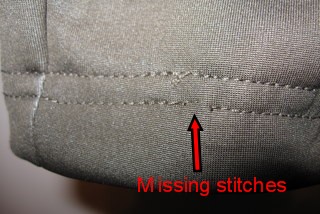 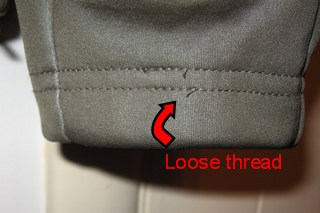
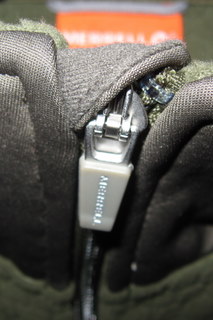 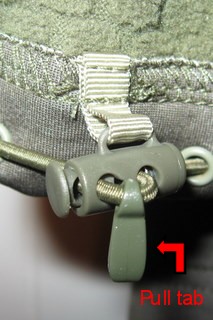 There are four zippers on the Atlas: one on the chest pocket, one full-length zipper from collar to hem, and one on each hand pocket. Each feel solid and operate smoothly. Both the chest pocket and the collar have fabric flaps that cover the zipper when it is closed. The collar has a piece of soft, brushed fabric protecting my neck/chin from the zipper. There are four zippers on the Atlas: one on the chest pocket, one full-length zipper from collar to hem, and one on each hand pocket. Each feel solid and operate smoothly. Both the chest pocket and the collar have fabric flaps that cover the zipper when it is closed. The collar has a piece of soft, brushed fabric protecting my neck/chin from the zipper.
The hem has a drawcord to help seal out the cold. There is one cord-lock on each side with a small plastic pull tab. These pieces seem small, and my first thought is: will I be able to operate them with gloves on? With bare fingers, they operate easily and feel solid and durable.
APPEARANCE:
This is one strange looking jacket. The raised honeycomb pattern combined with the various reversed panels found throughout give the Atlas a very unique look. It is sort of like a cross between a Motocross jacket and a Star Trek uniform. Seriously.
One small quibble about the appearance. The colors on Merrell's website are not very true to reality. Compare the picture below, which is pretty close to how it looks in person, to the picture at the beginning of this report, which is taken from Merrell's website. Pretty far off, if you ask me.
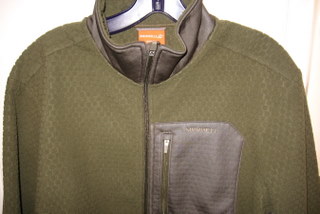
TRYING IT OUT
FIT:
I opted for the men's medium, even though I was pushing the upper limit of the measurements for that size according to Merrell's sizing chart. Glad I did, because the Atlas fits me perfectly. It is a fairly close fit, but in no way tight or uncomfortable. It is somewhat of a stiff fabric - not at all the typically soft fleece I am used to. But it stretches wonderfully. As I flexed my arms and back, the fabric moved with me. The only annoyance was that the sleeves pulled up short when I would stretch my arms out in front of me. It was a strange position that I don't anticipate recreating in a real situation, but it still bothered me. Otherwise, the jacket felt great: a slim, athletic fit, but with enough stretch to easily allow a full range of motion.
Next, I put gloves on to see how they fit with the Atlas. My lightweight gloves had no trouble fitting their small cuffs inside the cuffs of the Atlas. My heavyweight gloves have full gauntlets, and these had no trouble fitting over the cuffs of the Atlas. So, it appears that the cuffs of the Atlas are just the right size: big enough to cover lightweight gloves, slim enough to allow a heavyweight gauntlet to cover them.
OPERATION:
I decided to see if the zippers and cord-locks were easily operational with gloves on. Everything was great with my lightweight gloves: the zippers functioned easily, as did the cord-locks. The cord-locks did not release too easily, however, when I wanted to loosen the hem. This required two hands to accomplish: one to press the release button on the lock, the other to pull the cord through. A small matter. I couldn't really do anything at all wearing my heavyweight gloves, but that is because they are bulky and fit terribly. Not the Atlas' fault at all.
I wore the jacket for a quick run to the coffee shop down the street, and it felt relatively warm on this 38 F (3 C) day. Wouldn't you know it, the first time out of the house, and the barista asks to feel my jacket. I knew this would happen, given its bizarre texture.
I'll have to wait until I take the Atlas out in the mountains to test wind-resistance, but I can certainly test water-resistance at home. After running the water over the sleeve for about two seconds, the fabric was completely soaked. Both the jersey and orbital fabrics soaked the water right up. It didn't look good, but to my surprise, the water didn't transfer through to the other side. Hmmm. Dry as a bone inside where it counts. Impressive. We'll see how it does after a day in the snow.
TESTING STRATEGY
I plan to use the Atlas mainly for snowshoeing, but also for just plain hiking in the cold and snow. The main features of the Atlas seem to be that it is both wind-proof and breathable. I plan to put these features to the test as snowshoeing up a mountain demands both. Can the Atlas combine both of these features while still offering enough insulation to keep me warm, especially when stationary?
Check back in two months for my Field Report.
Dave Tagnani
FIELD REPORT
FIELD LOCATIONS AND CONDITIONS - Feb 09
Over the past two months, the Atlas has been the jacket for every snowshoeing and hiking trip I've been on. The Atlas has seen twelve days of use in true field conditions and nearly as many days of casual use.
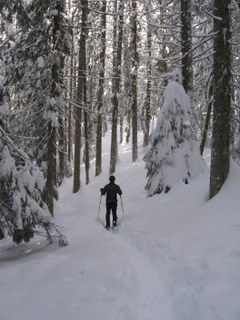 | | Snowshoeing on Mt. Spokane |
Mt. Spokane State Park:
Mt. Spokane is a 5883 ft (1793 m) mountain that dominates the skyline north of Spokane. This has been my primary snowshoeing destination this winter. I've been on seven trips there this winter, the lengthiest and most challenging of which was an 8 mile (13 kilometer) snowshoe with 1400 feet (420 meters) of elevation gain. The weather has been crazy this year: Spokane recorded the most snowfall in one month since records have been kept. On most trips, the weather was grey, windy, and cold -- usually around 25 F (-4 C). Recently, it has warmed up a bit, and the temperature on my last trip was around 38 F (-3 C).
Colville National Forest:
This is an expansive forest just north of Spokane. Colville offers a wilder, less developed area to explore. I was able to get up there before the snow fell to practice my off-trail navigation skills. My lone hike in this area was 6 miles (10 kilometers) with 1000 feet (305 meters) of elevation gain.
Riverside State Park:
This is my quick, close-to-home destination. I've been on one hike and three snowshoe trips there during the testing period. Riverside is a relatively flat park stretching for many miles along the banks of the Spokane River. My trips there average 5 miles (8 kilometers) with negligible elevation change. I frequently leave the trails here and wander through the brush.
PERFORMANCE IN THE FIELD
The Atlas has endured two months of uniformly bad weather. Spokane broke the all time record for the most snow in a one-month period this winter. There was plenty of nastiness to challenge this jacket.
I pretty much wore the same layers every time out with the Atlas: first layer -- mid-weight long underwear top; second layer -- wool sweater or long-sleeve crew top, depending on the temps; and finally -- the Atlas. I always wore a hat and gloves; I never wore a scarf.
Fit / Comfort:
The Atlas fits exactly as I need it to. It is a close fit so that during active pursuits -- like climbing a mountain in snowshoes -- it never felt bulky or in the way. But it also has enough room for me to wear insulating layers underneath. On colder outings, I had no problems layering a wool sweater underneath the Atlas.
Another thing that makes the Atlas a comfortable fit is how well it stretches and moves with me. Trudging up mountains, pumping my arms, digging in with trekking poles . . . the Atlas easily accommodated all movements.
Though the Atlas fits exceptionally well, it is not the most comfortable jacket I've ever worn. Not that it is terribly uncomfortable, but the fabric is a bit stiff and not quite as soft and forgiving as many other fleece jackets.
Warmth:
I was a bit surprised at how thin the Atlas was when I first received it, and this made me wonder how warm it could possibly be. Well, my experience has been that it is much warmer than I ever would have thought. This is not the jacket I would wear if I was going to be standing around in below-freezing temperatures. But this was the jacket I chose to wear anytime I was going to be moving quite a bit, even when I knew it was going to be freezing outside. The Atlas kept me warm while traversing bare snowfields with the wind whipping the snow around. I kept me warm when stationary, too, if I didn't stay that way for too long.
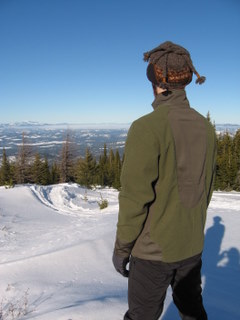 | | On the peak of Day Mt. |
Breathability:
I'm always skeptical when a piece of gear claims to be wind-resistant, water-resistant, and breathable. I'm no physicist, but that seems impossible. Alas, maybe it is, because the Atlas can't do all three. It is not very breathable. The Atlas has no vents, and as it is, not too much heat or perspiration seems to escape through the fabric. When working hard on extended inclines, I usually had to take the Atlas off and put it in my pack. I was just too warm and sweat began to build up, even though it was cold and snowy in the mountains.
Water-Resistance:
The Atlas was not challenged too greatly in this regard. It snowed on a few outings, but the snow was dry and light, and the Atlas was able to keep me dry with no problems. More impressive is the fact that even after hours of my snowshoes kicking snow up onto the back of the jacket, it kept the moisture out.
Wind-Resistance:
One anecdote really exemplifies how the jacket excels in this area. Like I said above, I usually removed the jacket when heading uphill. On one trip, after I turned around and started heading downhill, I began to get very cold. I determined this was because I was now wearing only a wool sweater, and I was heading downhill fast, so the wind was going right through it. I stopped, put the Atlas back on, and the problem was solved. Not even a slight chill did I feel from then on. The Atlas has been a great shield from the cold winter winds.
Durability:
Despite some bushwhacking in the Atlas, there are no noticeable signs of wear yet. It seems to be holding up just fine. It looks the same as the day I got it. All zippers, cords, and cord locks are functioning like new.
SUMMARY
The Atlas is not perfect: it does not breathe very well. And the fabric is not the most comfortable fabric I've experienced. But at the same time it has proven to be a very water- and wind-resistant jacket that is warmer than I would have ever thought possible, judging by the weight of the fabric. And it fits like a glove. All in all, it has been a great jacket for my winter pursuits.
Things I Like:
Good protection from wind and water
Perfect fit - close yet with room for layers
Warmer than it looks
Stretches easily
Things I Don't Like:
Not very breathable
Kinda weird looking
Fabric is a bit stiff
This concludes my Field Report. The Long-Term Report should be completed by mid-April. Please check back then for further information.
Dave Tagnani
LONG-TERM REPORT
LONG-TERM TEST CONDITIONS - April 09
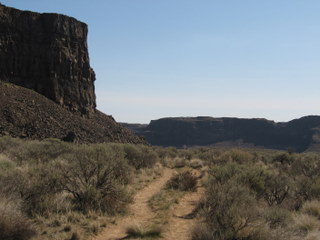 | | The high desert of Washington |
The Atlas Fleece has accompanied me on just two more snowshoe outings. These were both to Mt. Spokane State Park (see my Field Report for a detailed description of the conditions there). The snow there soon became too consolidated to really require snowshoes, and other areas near me became more attractive.
One of these areas is the steppe terrain to the west of Spokane knows as the Channeled Scablands. This is essentially a high desert, with few trees and little water. This area is great for early season hikes, but is usually pretty windy. The Atlas was my jacket of choice on a few hikes through various parcels of BLM land. Temperatures during these hikes ranged from a low of around 35 F (1.7 C) to a high of about 50 F (10 C). Winds were usually strong and sustained.
PERFORMANCE IN THE FIELD
The Atlas continued to perform as before on my snowshoe outings. I'll not go in to detail here, as you can read about it above in my Field Report. I will, however, offer some thoughts about the Atlas's performance during my snow-free, warmer weather outings in the high desert.
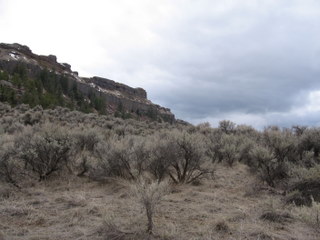 | | Northrup Canyon |
The Atlas seemed to be the logical choice for a shell, since the high desert is usually windy during the winter and early spring. This was a good test for its wind protection capabilities, and the Atlas performed well in this regard. Maybe too well, as a matter of fact. Since the temperatures on these hikes were a little warmer than on my snowshoe outings, the Atlas actually kept me a bit too warm. As I warmed up from hiking, the Atlas didn't seem to breathe too well. It absolutely blocked the wind, but I actually found myself unzipping the jacket to let some of the wind in for ventilation. This zipper is not that effective, however, when wearing a pack with a waist belt and sternum strap.
When I stopped for breaks, the Atlas was great to have. Since it blocked the wind effectively, it kept me warm when stationary. And since I wasn't generating my own heat any longer, I was not too warm or stuffy.
SUMMARY
The Atlas has continued to perform as expected, given my experiences during the Field Report. It has offered me superior protection from the wind, but sub-par breathability. This was less of an issue in colder weather; it became more of an issue as the temperatures increased. I have now found myself reaching for more breathable, less wind resistant layers when I head outdoors.
I am pleased with the craftsmanship and durability of the Atlas. Aside from a few loose threads from the factory, the jacket has shown no signs of wear and tear, despite some off-trail bushwhacking and lots of use in general. Those loose threads have not translated into separating seams.
All in all, I am happy with the Atlas jacket. My main disappointment is the lack of breathability, but I have yet to find any product that combines wind protection with breathability. The Atlas has been a solid choice for my high-exertion winter pursuits and more mellow shoulder season outings.
Thanks to Merrell and BackpackGearTest.org for the opportunity to test the Atlas jacket.
Dave Tagnani
This report was created with the BackpackGearTest.org Report Writer Version 1.
Copyright 2009. All rights reserved.
Read more gear reviews by David Tagnani
|




